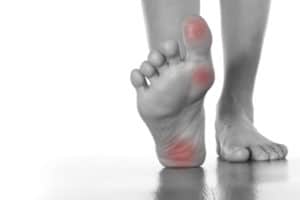 “Oh, my aching feet…”
“Oh, my aching feet…”
How many times have you heard someone say that? While it’s common for your feet to be somewhat sore after, say, walking the Silver Course at Soldier Hollow or hiking to Timpanogos Cave, regular foot pain is not normal.
At our five Foot & Ankle Clinics of Utah, we’re all about getting our patients past the pain and back on their feet.
In this February blog, let’s get into just what makes up those dogs down there putting in the 75,000 miles the average person walks by the time they turn 50.
Foot structure
The foot can be divided into three sections: the forefoot, midfoot, and hindfoot. There are bones, joints, muscles, tendons, and ligaments in each section.
- Forefoot — This is the front of your foot, including your toes. There are 14 different toe bones (two per big toe and three on the other four), plus five metatarsals. The first metatarsal bone is the shortest and thickest and plays an important role during forward movement. It also provides attachment to several tendons. In addition to the toes and the metatarsals, the forefoot contains two small, oval-shaped sesamoid bones just beneath the head of the first metatarsal, on the plantar surface, or underside, of the foot, which are held in place by tendons and ligaments.
- Midfoot — This section of the foot is made up of five irregularly shaped bones called the tarsals. These form the arch of the foot. The arch of the foot plays a key role in weight-bearing and stability.
- Hindfoot — There are only two large bones in this section of the foot: the talus and the calcaneus. The calcaneus is larger and forms the heel. The talus rests atop the calcaneus and forms the pivoting joint of the ankle.
- Joints — Where two or more bones meet, that’s a joint. Each big toe has two joints; the other four toes on each foot have three joints.
- Muscles — The muscles that control our foot movements originate in the lower leg and are attached to the bones in the foot with tendons.
- Tendons and ligaments — The most notable (and well known) tendon of the foot is the Achilles tendon, which runs from the calf muscle to the heel. It is the strongest and largest tendinous structure in the body. The Achilles tendon makes it possible to run, jump, climb stairs, and stand on your toes. The primary ligament of the foot is the plantar fascia. It runs from the heel to the toes on the sole of the foot. It forms the arch and provides strength for walking and assisting with balance. There are two smaller ligaments in the foot along with the plantar fascia.
Now that you’re a foot anatomy expert, if you have chronic foot pain, we need to see you at Foot & Ankle Clinics of Utah. Give us a call at any of our five locations in American Fork (801), 763-3885; Payson, (801) 765-1718; Springville (801) 491-3668; and Orem (two locations), (801) 226-2421 or (801) 765-1718.
